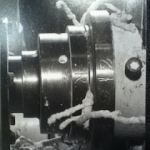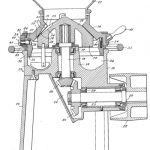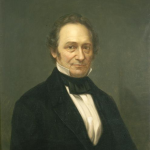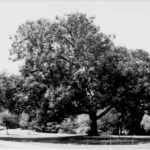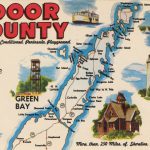By the mid-1930s, the Flakall Corporation was trying to build up a customer base for its machine, a version of the feed grinder initially designed and built by Clair Mathews. As it turned out, the machine would end up being more useful for snack food manufacturers than farmers.
When called by a local farmer to service his grinding machine, Edward Wilson, a Flakall machinist and stockholder in the corporation, noticed the puffed end product, called collettes, and took some of them to his Beloit home where he and his wife experimented with flavoring them in the kitchen. Although intended for farm feed, the Wilsons were not the first people to eat them. As Jacqueline Dougan Jackson recounts, farm workers at the Dougan Dairy Farm and the Dougan family, had been snacking on the product for some time.[1]
The Flakall Corporation, unsure how to name the product, ran a naming contest. A blind woman, who thought that the snack felt like curly hair, came up with the word “kurl.” With a name in hand and a flavored snack to sell, the Korn Kurl was born.
Wilson did not work long for the Korn Kurl industry though, as he returned to active duty with the U.S. Navy before the United States’ involvement in World War II. Upon leaving, Wilson transferred his ownership stake in the Korn Kurl business to Melbourne Reed, and he left his wife in charge of his Flakall Corporation stock, which she sold to Harry Adams.
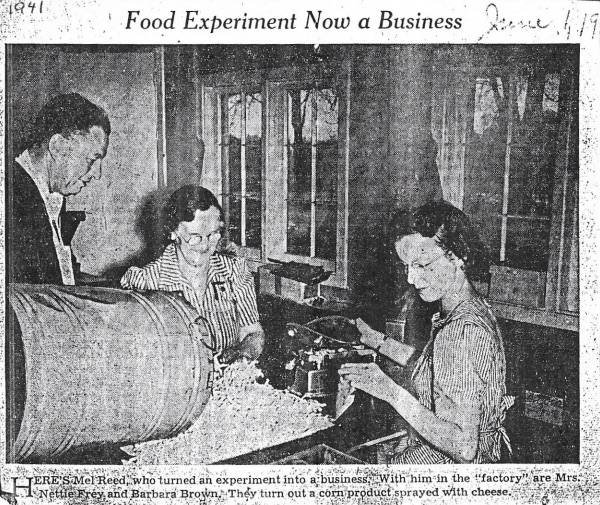
Reed, like Wilson, also worked for the Flakall Corporation and was intrigued by the puffy end product of the Flakall machines. He and his wife had experimented with flavoring them at their home in Darien and tried different preparation methods. They tried toasting the sticks, coating the sticks in candy, coating the sticks in yellow corn meal and frying them, and applying a cheese coating. The Reeds would take their samples to L.T. Wheeler’s tavern and hand them out to friends, allowing them to pick which flavors they liked best. By 1938, their tavern friends had spoken, saying the method of French-frying the puffs and then coating them with cheese was the tastiest combination.[2] They even suggested selling the sticks at five cents per bag.[3]
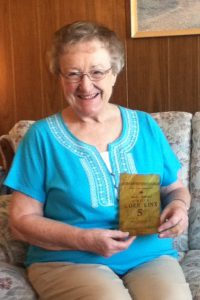
The Reeds turned their kitchen, and then their garage, into a manufacturing plant, purchasing puffs from the Flakall Corporation to create their snack, known as Reed’s Korn Kinx. As business grew, they added a building to the garage to meet the growing demand. In 1939, Reed reported purchasing 75,000 pounds of curls from Flakall and selling 1,500,000 bags of Korn Kinx.[4]
In December 1940, Reed bought out Edward Wilson’s company, and with it came the name and franchise rights for Korn Kurls, which were still held by the Flakall Corporation. Reed’s Food Products employed eight women in Darien to work in the factory, and by 1941 the company was distributing Korn Kurls, popcorn, and salted in-shell peanuts across the state of Wisconsin, as well as in parts of Illinois, Michigan, and Minnesota.[5]
Reed’s success distributing Korn Kurls was short lived, however. During World War II, the production of snack products, including Korn Kurls, was curtailed due to a rationing of corn, cheese, and frying oils. Reed would continue to operate Reed’s Food Products until 1951, when poor health forced him to sell his business and move to Texas.[6]
While World War II caused a short-term halt in the production of Korn Kurls, it would not be the end of the product. By 1945, Harry Adams and his two sons, Allan Adams and Arthur Adams, owned a controlling interest in the Flakall corporation.[7] The Adams family organized Adams Corporation to manage the manufacturing and distribution of Korn Kurls.[8] The Flakall Corporation, a subsidiary and the parent corporation of the Adams firm, continued to produce the collettes used to create the snack.[9] The Adams Corporation also held a controlling interest in Dell Foods, which specialized in manufacturing cheese mixes.[10] Beatrice Foods acquired all three companies in 1961, and Allan became President of Adams International, where he sold flaking machines and set up snack food operations throughout Europe and South America.[11]
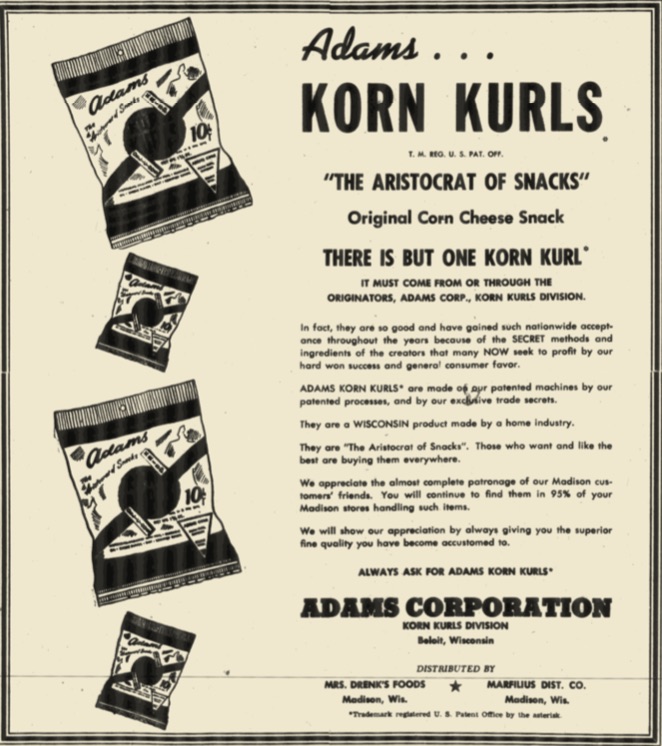
In the 1990s, Adams International was purchased by Maddox Metal Works, a company that manufactures machines that produce snack foods. Maddox had been making parts for Frito Corporation, a partnership that continued to grow after the merger between Frito and H.W. Lay & Company and the subsequent acquisition of Frito-Lay by PepsiCo. The original Frito corn curl, the Cheeto, would outlive the Adams Corporation’s Korn Kurl, but Frito-Lay opened a factory that operates with machines made by Maddox Metal Works in Beloit, Wisconsin, so the legacy of the Korn Kurl lives on.[12]
Written by Cheryl Kaufenberg.
FOOTNOTES
[1] Jacqueline Dougan Jackson, The Round Barn: A Biography of an American Farm, (Beloit, Wisc.: Beloit College Press, 2011).
[2] “Queer Bits of Food are Now Filling a Factory,” Milwaukee Journal Special Correspondence, June, 1941.
[3] “Darien Food Products Business Moves off Kitchen Stove Into Own Building: Is Still Growing,” Beloit Daily News, February 13, 1941.
[4] Ibid.
[5] Ibid.
[6] Janesville Daily Gazette, December 26, 1953.
[7] Monroe Evening Times, April 06, 1951.
[8] Jacqueline Dougan Jackson, The Round Barn.
[9] Janesville Daily Gazette, April 26, 1952.
[10] Jacqueline Dougan Jackson, The Round Barn.
[11] Ibid.
[12] Maddox Metal Works: About Us, accessed September 23, 2019, http://www.maddoxmetalworks.com/aboutus.htm., Ernie Smith, “A Brief History of the Cheese Curl, Junk Food’s Happiest Accident,” Atlas Obscura (November 14, 2017), https://www.atlasobscura.com/articles/a-brief-history-of-the-cheese-curl-junk-foods-happiest-accident.
